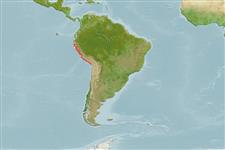Genypterus maculatus (Tschudi, 1846)
Black cusk-eel
Add your observation in Fish Watcher
| Native range | All suitable habitat | Point map | Year 2050 |

|
| This map was computer-generated and has not yet been reviewed. |
| Genypterus maculatus AquaMaps Data sources: GBIF OBIS |
Upload your photos and videos
Pictures | Google imageGenypterus maculatus
Picture by Béarez, P.
Pictures | Google imageGenypterus maculatus
Picture by Béarez, P.
Chile country information
Common names:
Congrio negro
Occurrence: native
Salinity: marine
Abundance: | Ref:
Importance: commercial | Ref: Nielsen, J.G., D.M. Cohen, D.F. Markle and C.R. Robins, 1999
Aquaculture: | Ref:
Regulations: | Ref:
Uses: no uses
Comments: Found in south-central zone off Chile (Ref. 56050). Also Ref. 5530, 8984, 9068, 27363.
National Checklist:
Country Information: https://www.cia.gov/library/publications/resources/the-world-factbook/geos/ci.html
National Fisheries Authority:
Occurrences: Occurrences Point map
Main Ref: Nielsen, J.G., D.M. Cohen, D.F. Markle and C.R. Robins, 1999
National Database:
Occurrence: native
Salinity: marine
Abundance: | Ref:
Importance: commercial | Ref: Nielsen, J.G., D.M. Cohen, D.F. Markle and C.R. Robins, 1999
Aquaculture: | Ref:
Regulations: | Ref:
Uses: no uses
Comments: Found in south-central zone off Chile (Ref. 56050). Also Ref. 5530, 8984, 9068, 27363.
National Checklist:
Country Information: https://www.cia.gov/library/publications/resources/the-world-factbook/geos/ci.html
National Fisheries Authority:
Occurrences: Occurrences Point map
Main Ref: Nielsen, J.G., D.M. Cohen, D.F. Markle and C.R. Robins, 1999
National Database:
Common names from other countries
Classification / Names Common names | Synonyms | Catalog of Fishes(genus, species) | ITIS | CoL | WoRMS | Cloffa
Teleostei (teleosts) > Ophidiiformes (Cusk eels) > Ophidiidae (Cusk-eels) > Ophidiinae
Etymology: Genypterus: Greek, geny, -yos = face, jaw + Greek, pteron, = wing, fin (Ref. 45335).
Etymology: Genypterus: Greek, geny, -yos = face, jaw + Greek, pteron, = wing, fin (Ref. 45335).
Issue
Needs a taxonomic reference.
Environment: milieu / climate zone / depth range / distribution range Ecology
Marine; demersal. Tropical; 4°S - 22°S, 82°W - 71°W (Ref. 34024)
Distribution Countries | FAO areas | Ecosystems | Occurrences | Point map | Introductions | Faunafri
Southeast Pacific: Peru to northern Chile.
Size / Weight / Age
Maturity: Lm ? range ? - ? cm
Max length : 100.0 cm TL male/unsexed; (Ref. 55763); common length : 50.0 cm TL male/unsexed; (Ref. 55763)
Max length : 100.0 cm TL male/unsexed; (Ref. 55763); common length : 50.0 cm TL male/unsexed; (Ref. 55763)
Common species found in rocky shelf and upper slope waters (Ref. 34024). Oviparous, with oval pelagic eggs floating in a gelatinous mass (Ref. 205).
Life cycle and mating behavior Maturity | Reproduction | Spawning | Eggs | Fecundity | Larvae
Main reference
Upload your references | References | Coordinator | Collaborators
Nielsen, J.G., D.M. Cohen, D.F. Markle and C.R. Robins, 1999. Ophidiiform fishes of the world (Order Ophidiiformes). An annotated and illustrated catalogue of pearlfishes, cusk-eels, brotulas and other ophidiiform fishes known to date. FAO Fish. Synop. 125(18):178p. Rome: FAO. (Ref. 34024)
Threat to humans
Harmless
Human uses
Fisheries: commercial
FAO(Fisheries: production; publication : search) | FIRMS (Stock assessments) | FishSource | Sea Around Us
More information
Trophic ecology
Food items
Diet composition
Food consumption
Food rations
Predators
Food items
Diet composition
Food consumption
Food rations
Predators
Ecology
Ecology
Home ranges
Ecology
Home ranges
Population dynamics
Growth parameters
Max. ages / sizes
Length-weight rel.
Length-length rel.
Length-frequencies
Mass conversion
Recruitment
Abundance
Growth parameters
Max. ages / sizes
Length-weight rel.
Length-length rel.
Length-frequencies
Mass conversion
Recruitment
Abundance
Life cycle
Reproduction
Maturity
Fecundity
Spawning
Spawning aggregations
Eggs
Egg development
Larvae
Larval dynamics
Reproduction
Maturity
Fecundity
Spawning
Spawning aggregations
Eggs
Egg development
Larvae
Larval dynamics
Anatomy
Gill area
Brain
Otolith
Gill area
Brain
Otolith
Physiology
Body composition
Nutrients
Oxygen consumption
Swimming type
Swimming speed
Visual pigments
Fish sound
Diseases & Parasites
Toxicity (LC50s)
Body composition
Nutrients
Oxygen consumption
Swimming type
Swimming speed
Visual pigments
Fish sound
Diseases & Parasites
Toxicity (LC50s)
Genetics
Genetics
Heterozygosity
Heritability
Genetics
Heterozygosity
Heritability
Human related
Aquaculture systems
Aquaculture profiles
Strains
Ciguatera cases
Stamps, coins, misc.
Aquaculture systems
Aquaculture profiles
Strains
Ciguatera cases
Stamps, coins, misc.
Tools
E-book | Field guide | Length-frequency wizard | Life-history tool | Point map | Classification Tree
| Catch-MSY |
Special reports
Download XML
Internet sources
Aquatic Commons | BHL | Cloffa | Websites from users | Check FishWatcher | CISTI | Catalog of Fishes(genus, species) | DiscoverLife | ECOTOX | Faunafri | Fishtrace | GenBank(genome, nucleotide) | GloBI | GOBASE | | Google Books | Google Scholar | Google | IGFA World Record | MitoFish | OsteoBase(skull, spine) | Otolith Atlas of Taiwan Fishes | PubMed | Reef Life Survey | Scirus | SeaLifeBase | Tree of Life | Wikipedia(Go, Search) | World Records Freshwater Fishing | Zoological Record
Estimates based on models
Preferred temperature (Ref. 115969): 7.9 - 11.1, mean 9.5 (based on 14 cells).
Phylogenetic diversity index (Ref. 82804): PD50 = 0.5156 [Uniqueness, from 0.5 = low to 2.0 = high].
Bayesian length-weight: a=0.00257 (0.00122 - 0.00544), b=3.17 (2.98 - 3.36), in cm Total Length, based on LWR estimates for this (Sub)family-body shape (Ref. 93245).
Trophic level (Ref. 69278): 4.0 ±0.7 se; based on size and trophs of closest relatives
Resilience (Ref. 120179): Medium, minimum population doubling time 1.4 - 4.4 years (Assuming tm<4).
Fishing Vulnerability (Ref. 59153): High vulnerability (60 of 100).
Climate Vulnerability (Ref. 125649): Very high vulnerability (89 of 100).




